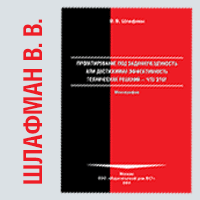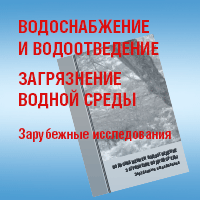№8|2014
WASTEWATER TREATMENT
bbk 000000
UDC 628.35:66.081.63
Calculation of membrane surface in membrane bioreactors
Summary
On the basis of the foreign publications analysis membrane bioreactors and membranes used in them are considered. In pressure units with a remote membrane assembly the specific flow through the membrane (at 20°C) is 80–200 l/(h∙m2) at 20–500 kPa transmembrane pressure; whereas in the units with submerged membranes – 8–30 l/(h∙m2) at 10–60 kPa vacuum. The specific power consumption in bioreactors with pressure membranes is within the limits of 1.5–4 kW·h/m3; with submerged membranes – 0.5–0.7 kW·h/m3. The results of analyzing the equipment market showed that submerged membrane elements and modules have been used in 97–99% biomembrane units. The comparison of submerged membranes shows that modules made of hollow fiber membranes have higher specific surface (300–600 m2/m3) compared to flat ones (50–150 m2/m3). Hollow fiber membranes are characterized by lower cost, higher resistance to fouling and backwashing. Flat membranes have higher mechanical toughness and can be more easily replaced. The operation of membrane batch bioreactors, the use of osmotic membrane bioreactor and nanofiltration processes in biomembrane technology are described. The technique of calculating submerged hollow fiber membrane surface with account of various allowed specific flows depending upon the durability of the design flows, time lost for backwashing and «relaxation», reflux from membrane backwashing is presented. At determining the number of the operating in parallel process lines one should take into account possible shutdown of one membrane tank for chemical washing or repair.
Key words
wastewater , biological treatment , transmembrane pressure , power consumption , membrane bioreactor , specific flow
The further text is accessible on a paid subscription.
For authorisation enter the login/password.
Or subscribe
REFERENCES
- Judd S. The MBR book: principles and applications of membrane bioreactors in water and wastewater treatment. Amsterdam, Elsevier Publ., 2007, 324 p.
- Barillon B., Ruel S. M., Langlais C., Lazarova V. Energy efficiency in membrane bioreactors. Water Science & Technology, 2013, v. 67 (12), pp. 2685–2691.
- Vidiakin A. M., Poliakov M. N. [Brief overview of MBR equipment market]. VodaMagazine, 2009, no. 6, pp. 28–31. (In Russian).
- Krampe J. Cycle-time determination and process control of sequencing batch membrane bioreactors. Water Science & Technology, 2013, v. 67 (9), pp. 2083–2090.
- Lobos J., Wisniewski C., Heran M., Grasmick A. Membrane bioreactor performances: effluent quality of continuous and sequencing systems for water reuse. Desalination: International Journal of the Science and Technology of Water Desalting, 2007, v. 204 (1–3), pp. 39–45.
- Laera G., Jin B., Lopez A. Application of sequencing batch membrane bioreactors (SB-MBR) for the treatment of municipal wastewater. Water Science & Technology, 2011, v. 64 (2), pp. 391–396.
- Choi J.-H., Fukushi K., Ngand H. Y., Yamamoto K. Evaluation of a long-term operation of a submerged nanofiltration membrane bioreactor (NF MBR) for advanced wastewater treatment. Water Science & Technology, 2006, v. 53 (6), pp. 131–136.
- Achilli A., Cath T. Y., Marchand E. A., Childress A. E. The forward osmosis membrane bioreactor: A low fouling alternative to MBR processes. Desalination: International Journal of the Science and Technology of Water Desalting, 2009, v. 238 (1–3), pp. 10–21.
- Cornelissen E. R., Harmsen D., Beerendonk E. F., et al. The innovative Osmotic Membrane Bioreactor (OMBR) for reuse of wastewater. Water Science & Technology, 2011, v. 63 (8), pp. 1557–1565.
- Qiu G., Ting Y.-P. Short-term fouling propensity and flux behavior in an osmotic membrane bioreactor for wastewater treatment. Desalination: International Journal of the Science and Technology of Water Desalting, 2014, v. 332 (1, 2), pp. 91–99.
- Shvetsov V. N., Morozova K. M. [Procedure of designing biological treatment facilities with nutrients removal]. Vodosnabzhenie i Sanitarnaia Tekhnika, 2013, no. 11, pp. 42–47. (In Russian).
- Stepanov S. V. [Specific features of designing oil refinery wastewater biological treatment facilities]. Vodosnabzhenie i Sanitarnaia Tekhnika, 2014, no. 3, pp. 49–56. (In Russian).
- SNiP 2.04.03-85. Kanalizatsiia. Naruzhnye seti i sooruzheniia [SNiP 2.04.03-85. Sewerage. Outdoor networks and structures. Moscow, TSITP of USSR Gosstroi Publ., 1986. 72 p.].
- Wedi D., Joss A. Dimensioning of membrane bioreactors for municipal wastewater treatment. Water Science & Technology, 2008, v. 57 (6), pp. 829–835.
- Stepanov S. V., Strelkov A. K., Stashok Iu. E., Dubman I. S., Beliakov A. V. [The experience of designing oil refinery wastewater treatment facilities]. Vodosnabzhenie i Sanitarnaia Tekhnika, 2013, no. 8, pp. 34–43. (In Russian).






